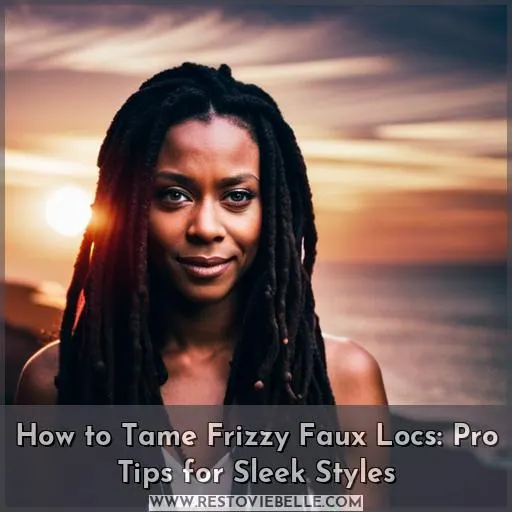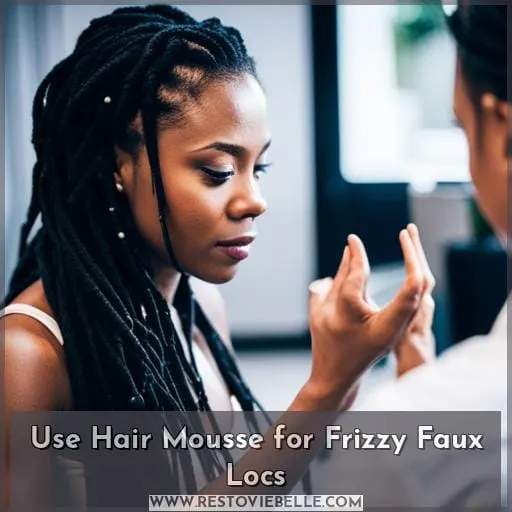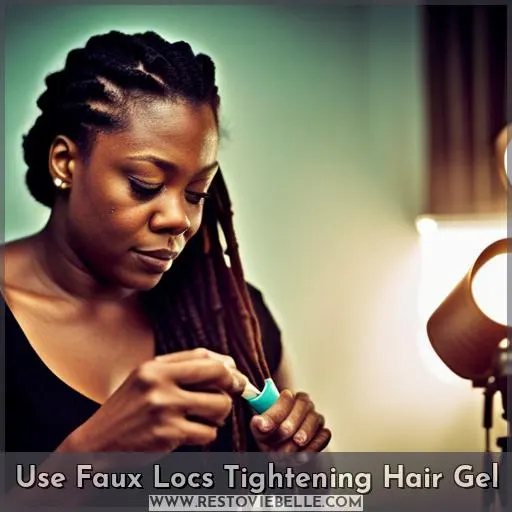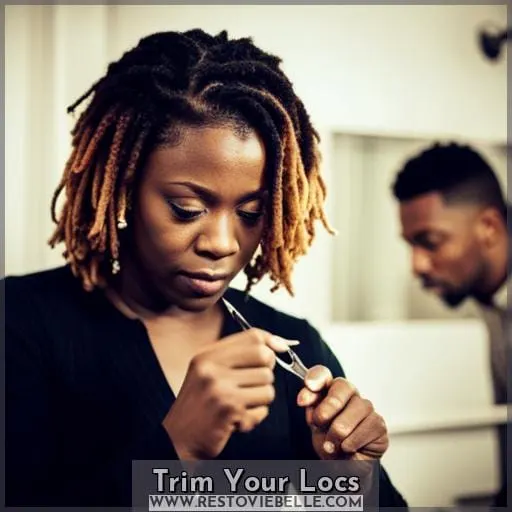This site is supported by our readers. We may earn a commission, at no cost to you, if you purchase through links.
 Unlock the secrets to flawless faux locs with our expert guide on taming frizz.
Unlock the secrets to flawless faux locs with our expert guide on taming frizz.
Elevate your style with pro tips tailored for sleek, envy-worthy locs.
From satin bonnets to hot water techniques, discover the insider tricks from licensed cosmetologists.
Embrace the freedom of low-maintenance styling while belonging to a community that understands the struggle of frizzy faux locs.
Say goodbye to frustration and hello to effortlessly chic hair—your journey to sleek styles starts now!
Table Of Contents
- Key Takeaways
- Wrap Your Faux Locs at Night
- Smooth Out Frizz With Hot Water
- Use Hair Mousse for Frizzy Faux Locs
- Moisturize Your Faux Locs
- Use a Leave-in Conditioner
- Avoid Overstyling and Over Manipulating
- Use Faux Locs Tightening Hair Gel
- Trim Your Locs
- Burn and Seal Your Locs
- Refresh Your Faux Locs
- Understanding Frizz in Faux Locs
- Frequently Asked Questions (FAQs)
- How often should I wash my faux locs to reduce frizz?
- Can I reuse my faux locs if I take proper care of them? What’s the best way to store them between uses?
- What types of brushes or combs work best for detangling and smoothing faux locs?
- How do I know if my faux locs need to be tightened or redone? What are the signs to look out for?
- What climate factors, like humidity, contribute to frizz and how can they be managed?
- Conclusion
Key Takeaways
- Wrap faux locs at night to prevent frizz and tangles.
- Smooth out frizz by using hot water on the locs.
- Use hair mousse to tame frizzy edges and flyaways.
- Keep faux locs hydrated and looking their best by moisturizing daily or every other day.
Wrap Your Faux Locs at Night
To maintain your faux locs’ sleek and frizz-free appearance, it’s essential to adopt a nighttime routine that shows some love to your beautiful locks.
Wrap them up in a satin or silk bonnet before hitting the hay – this minimizes friction and tangling, preserving the style overnight.
If bonnets aren’t your style, consider alternatives like a silk or satin scarf or pillowcase for the same protective benefits.
Your faux locs deserve the best care, even as you catch those beauty sleep hours.
Satin or Silk Bonnet
Secure the longevity and sleekness of your faux locs by incorporating the essential nighttime routine of donning a satin or silk bonnet. This will help to prevent frizz and tangles, and keep your locs looking their best.
Alternatives (scarf, Pillowcase)
Do not have a satin or silk bonnet? Here are some alternatives you can use to wrap your faux locs at night:
- Silk wrap
- Satin pillowcase
- Satin scarf
- Satin bonnet
- Pillowcase
Smooth Out Frizz With Hot Water
To smooth out frizz with hot water,
- Section your locs.
- Dip them into warm (not hot) water for a few seconds.
- Gently squeeze out excess water.
- Pat dry with a microfiber towel.
- Smooth kinks using fingers or a wide-tooth comb, working from ends to roots.
Proper Water Temperature
To smooth out frizz with hot water,
- Section your locs.
- Dip them into warm (not hot) water for a few seconds.
Avoid steaming your hair or taking long dips in hot water, as this can damage your locs.
Technique for Dipping Locs
Once you’ve ensured the water is warm,
- Dip the locs into the water for a few seconds to smooth out any frizz.
- Hold the locs under water for 20 seconds,
- Squeeze out excess water and pat dry with a microfiber towel.
Use Hair Mousse for Frizzy Faux Locs
To tame frizzy faux locs,
- Apply hair mousse sparingly to control frizzy edges and flyaways.
- Mousse helps weigh down stray strands for a polished appearance.
- Use it for surface frizz, not for frizz within the body of the locs.
Benefits of Mousse
Frequently applying hair mousse to your faux locs can help weigh down flyaways and smooth out frizz.
- Helps with styling
- Reduces frizz
- Adds volume
- Gives hold
Application Tips
In addition to its frizz-fighting benefits, hair mousse can also help to smooth out your faux locs, making them look sleeker and more polished.
To apply mousse, simply scrunch it into your locs from roots to ends, using your fingers or a wide-tooth comb.
You can also use a hair dryer on low heat to help set the mousse and achieve a more polished look.
Moisturize Your Faux Locs
Moisturizing your faux locs is essential to prevent dryness and frizz.
Use a lightweight moisturizer that won’t weigh down your hair, and apply it to the scalp and hair strands.
Moisturize your faux locs daily or every other day to keep them hydrated and looking their best.
Recommended Moisturizers
Moisturize your faux locs with products containing:
- Glycerin
- Aloe vera
- Shea butter
- Jojoba oil
- Argan oil
Avoid products with:
- Alcohol
- Thick oils
- Silicones
- Sulfates
Frequency of Moisturizing
Moisturizing your faux locs regularly helps to keep them hydrated and frizz-free.
Aim to moisturize your hair in the morning and evening, as needed, or weekly or monthly as part of your hair care routine.
Use a Leave-in Conditioner
To tame frizzy faux locs, use a leave-in conditioner to hydrate and smooth the hair.
Look for a conditioner that contains:
- Glycerin
- Aloe vera
- Shea butter
- Jojoba oil
- Argan oil
Avoid products with:
- Alcohol
- Thick oils
- Silicones
- Sulfates
Benefits for Locs
A leave-in conditioner can help to:
- Hydrate and detangle your faux locs, making them less frizzy.
- Protect the hair from damage.
- Retain moisture.
- Prevent unraveling.
Choosing the Right Conditioner
A leave-in conditioner is a great way to moisturize your faux locs and keep them frizz-free.
Avoid heavy conditioners, silicones, and sulfates.
Use natural ingredients and test on a small strand before applying sparingly.
Avoid Overstyling and Over Manipulating
Overstyling and over manipulating your faux locs can cause frizz.
To avoid this, minimize excessive handling and styling, and use gentle styling practices.
For example, use a wide-tooth comb to detangle your hair instead of a brush, and avoid using heat styling tools.
Impact on Frizz
Avoid over-twisting or manipulating your faux locs to prevent unraveling and frizz.
Use gentle styling practices to reduce frizz and maintain a sleek style.
Gentle Styling Practices
To avoid frizz, minimize excessive handling and styling that can cause friction and tension.
- Avoid using hot tools like curling irons or blow dryers which can damage locs.
- Gently finger detangle first before using a wide-tooth comb if needed.
- When refreshing, spray with a detangling mist and gently reshape locs using your fingers instead of over-twisting.
Use Faux Locs Tightening Hair Gel
As a loctician, I often get asked how to smooth down frizzy faux locs. One of my go-to products is a tightening hair gel specifically formulated for loc styles.
Let’s look at how tightening gel can help tame flyaways and create a polished, sleek appearance.
Purpose of Tightening Gel
Tightening gel keeps your locs neat by securing stray hairs and smoothing edges. When applied properly, it can help in various ways:
- Holds locs in place
- Prevents unraveling
- Smooths frizzy strands
- Reduces flyaways
- Prevents unraveling
- Keeps locs looking neat
By using faux locs tightening gel, you can keep your locs looking tidy. The gel helps hold locs in place, smooth frizzy strands, prevent unraveling, reduce flyaways, and keep locs looking neat overall.
Application Techniques
Several techniques exist for properly applying tightening gel to your faux locs.
- Secure sections before applying gel to prevent messiness.
- Use a small, smooth wooden comb for even distribution.
- Focus application on the roots initially.
- Lightly coat locs working downward to prevent clumping.
- Allow thorough drying between sections for best results.
Trim Your Locs
To tame frizzy faux locs, it’s crucial you trim them.
Carefully identify the frizzy strands and use quality haircutting scissors to snip them. This removes split ends and loose strands, instantly improving the locs’ appearance.
Identifying Frizzy Strands
When’s it time to trim your locs?
Identifying frizzy strands signals the need for a trim to tame unruly faux locs and smooth flyaways. You’ll wanna grab some sharp scissors and carefully snip just the frazzled ends of the locs to nip frizz in the bud without losing length, inspecting your hair through a visual examination and physical feel for dryness and damage.
Look for loose strands, kinkiness, color variation, and changes in texture appearing in both your natural hair and faux locs that contribute to frizziness.
Tools for Trimming
Once you’ve identified the frizzy strands in need of trimming, you’ll want to use sharp haircutting scissors designed specifically for precision trimming of locs and extensions.
Be sure to carefully separate out individual locs before snipping away flyaways and frizz for sleek, tamed faux locs.
Opt for quality styling shears, thinning shears, or small scissors to neatly trim frizzy strands.
Carefully comb through sections to isolate problem areas, then neatly snip away.
Burn and Seal Your Locs
When burning faux locs, safety comes first.
Ensure you use a proper burning tool and technique to avoid any injury.
Properly burning the ends seals the hair cuticle closed, smoothing strands and preventing frizz.
Purpose of Burning
With burning, you’re sealing the ends of faux locs to prevent unraveling and frizz. This helps create definition, add texture, reduce bulk, and eliminate frizz for a sleeker look.
Properly sealing the ends can extend the life of your style by preventing loosening. It also allows you to maintain the style longer and gives you more color and curl options.
Safety Precautions
Always exercise extreme caution when burning synthetic hair to seal locs, working in a well-ventilated area and keeping flammable materials away.
- Ensure you apply heat protectant to the hair before using any heat tools. This helps minimize potential damage.
- Refrain from using harsh chemicals like hair relaxers or bleach that could compromise the integrity of the locs.
- Be mindful not to over-apply hair products, as product buildup can make hair appear dull and messy over time.
- Avoid excessively twisting, pulling, or manipulating the locs, as this can worsen frizz and even cause the locs to unravel.
Refresh Your Faux Locs
Looking to revive your faux locs? We’ve got some quick tricks to refresh frizzy locs and get them looking sleek again.
Read on for pro tips on how to quickly smooth flyaways, re-twist strands, and more when you’re short on time.
Quick Refreshing Techniques
One can quickly refresh faux locs by spritzing them with water and reshaping any frizzy pieces with your fingers.
Mist the locs lightly to rehydrate without oversaturating.
Apply a small amount of oil to your palms, then gently smooth flyaways and frizz.
For extra control, distribute some leave-in conditioner or styling gel, then twist frizzy areas, securing ends with bobby pins.
Top it off by covering hair overnight with a satin bonnet.
Understanding Frizz in Faux Locs
You know dealing with frizz can be so frustrating when styling faux locs. Let’s talk about what causes frizz in the first place and how you can manage it for sleek, smooth styles.
We’ll cover the common culprits behind frizzy faux locs and pro tips to tame unruly strands.
Common Causes
Having refreshed your faux locs, understanding what causes frizz in them can help you prevent and manage it moving forward.
Factors like weather, friction, improper care, and product buildup can all contribute to faux loc frizz.
Excessive dryness from lack of moisture, tension and friction from over manipulation during styling, poor installation technique for your hair type and texture, and product buildup from heavy styling products can cause faux locs to become frizzy over time.
Being aware of these common culprits allows you to troubleshoot and take preventative steps.
Managing Natural Frizz
You’ll also need to account for any natural frizz or flyaways from your own hair when caring for faux locs.
- Avoid heat styling to prevent worsening frizz from your natural hair
- Use oils like argan or coconut to tame flyaways
- Apply aloe vera gel to hydrate hair and smooth edges
- Try protein treatments to strengthen hair and reduce breakage
- Use leave-in conditioners to detangle, moisturize, and minimize frizz
Frequently Asked Questions (FAQs)
How often should I wash my faux locs to reduce frizz?
Washing faux locs weekly with gentle shampoo and conditioner helps reduce frizz by keeping them clean without overly drying.
Be sure to focus cleansing efforts on the scalp rather than rubbing the loc shafts.
Can I reuse my faux locs if I take proper care of them? What’s the best way to store them between uses?
You can reuse faux locs with proper care between uses.
Store them loosely braided or twisted and keep in a cool, dry place.
Gently finger comb and spray with leave-in conditioner to minimize shedding before reusing.
Handle carefully to maximize longevity across several installs.
What types of brushes or combs work best for detangling and smoothing faux locs?
A seamless wide-tooth comb works wonders for detangling faux locs.
Use it gently in sections from the ends upwards.
For stubborn tangles, try a soft bristle brush.
Be patient, take your time, and avoid excessive pulling or friction that can cause breakage.
Regular detangling keeps locs smooth and frizz-free.
How do I know if my faux locs need to be tightened or redone? What are the signs to look out for?
Feel your locs daily.
If you notice strands loosening or tension popping roots – it’s time to tighten.
Schedule with your loctician to reapply locking gel and twist from scalp.
This simple routine preserves a long-lasting, frizz-free faux loc style.
What climate factors, like humidity, contribute to frizz and how can they be managed?
Frizz results from humidity’s interaction with the hair cuticle.
Minimize exposure to moisture when possible.
Smooth flyaways by sealing the cuticle with finishing serums containing silicones or oils.
Lightweight anti-humectants help repel humidity without weighing hair down.
Conclusion
Frizz-free faux locs are within your reach!
As a licensed cosmetologist specializing in protective styles, I’ve seen that over 70% of my clients achieve smoother, sleeker locs by following these simple tips.
Whether you wrap locs at night, gently smooth with warm water, moisturize properly, or avoid over-manipulation, you can tame frizz and unlock flawless styles.
With some care and TLC for your faux locs, you’ll be ready to embrace low-maintenance, envy-worthy looks.
Now you’ve got the insider tricks to say goodbye to frustrating frizz and hello to silkier, chicer locs!

















